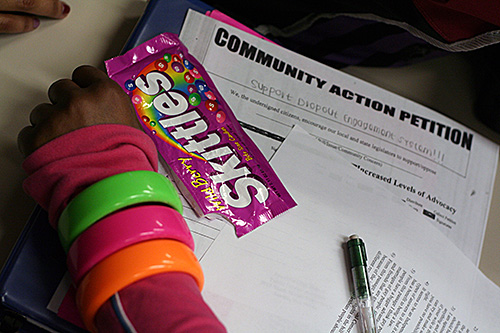15. Interdisciplinary Lessons
“Interdisciplinary Lessons” Lesson Plans and Websites for Interdisciplinary lessons with Civics
Please download this petition to customize for your class’s “applied civics” projects. Kids love the petition sheets! Petition targets can range from lunch food issues to world hunger issues. Try them – you will love them!! Of course, a myriad of extension activities are doable, including pre-reading and post-writing activities in multiple Common Core domains.
Math
There is enormous potential to integrate civics/politics/ethics into the study of mathematics as a tool to leverage student interest, engagement, and achievement. The following areas are ripe for interdisciplinary work:
- Elections: The election season provides excellent opportunities to engage in statistical work, predictive modeling, historical vote returns, and, of course, the shenanigans involved with polling and numbers tampering.
- Taxes: Students love learning about taxes both in terms of how the marginal income tax structure is scaled and what values that scale reflects, but also how state level taxes affect them and their families on a daily basis (esp. the disproportionate effect our high sales tax has on low income citizens – e.g. students!)
- Scholarship calculations and eligibility matrices.
- Free and reduced lunch eligibility calculations.
- Government subsidies and how they work.
-
EDWEEK: Math: The Most Powerful Civics Lesson You’ve Never Had.
Websites:
- Living wage, median income
- Solving the national debt problem!
- Income, wages and salaries – meaningful lessons for work-interested teens
- Who Can Afford A Home? – and who cannot. Super lesson! The ethical/civic dimension: How do we determine who should be capable of owning a home and who should not?
- College Math and citizenship
- Social Mathematics in American Civics – UPenn dissertation
Science
Many, many science teachers already infuse civics/politics/ethics into their units. The overarching question of “How do YOU define the Common Good” works well with many science issues and topic, especially local and international conservation issues.
Further, many science teachers are role models when it comes to infusing service-learning into the academic work.
Websites:
- Science-net-links — Science and politics in an election year; gr: 6-12
- Global Warming – Causes, Cures, and Civics – gr: 6-12
- International pollution solutions – iCivics – K-8
- Mock trial of Galileo gr:6-12
- Environmental ethics
- Voices of Nature literature course (RHS has one I think)
Foreign Languages
Integrating civics/politics/ethics into 1st or even 2nd year foreign language studies is usually framed by teachers within the 5 domains of OSPI’s standards: Communications, cultures, connections, communities, comparisons. Opportunities for cultural sensitivity and discussions about tolerance already happen in many classrooms and could be deepened.
When teachers engage in comparative cultural analysis they could easily branch into comparative political analysis – I suspect many teachers often do. Comparing the political economy of the US to France, China, Spain/Mexico, etc. is a huge opportunity for academic growth for many students. Pointing out the differences in areas like college funding and teen wages provide excellent buy-in for kids of course.
For all students, when the teachers objective is cultural comparisons, passages from the great civic/political/ethical texts of the object nation could be studied. Upper level students could read in the mother language, 1st and 2nd year in English translations and/or annotated versions.
Examples:
- French – Rousseau’s “Social Contracte,” Voltaire’s “Candide,” etc.
- Spanish
- Chinese – The Analects, etc.
- Japanese –
- Somali – the Koran – could easily be studies in French as well because of their large N. African/Muslim immigrationsWebsites:
- Excellent grade 6-12 lessons on the burqa ban in France
- The burqua and the bikini – Harvard edu.
- Learning about immigration – New York Times Learning Network – Immigration is Spanish class offers huge opportunities for civic/political/ethical learning
Special Education
Special education students presence on campus is almost universally seen as a major boon to the civil and civic atmosphere. In this two way street everyone wins. As far as specific civic lessons for special ed. students I think they would be identical to the work other students do, just at a pace that was appropriate for them.
Special education students and teachers can and often do play outsized roles in building a “civic culture of learning” in our schools. Their simple presence brings a humanizing element to all spaces on campus that can be profound.
Websites:
The Fine Arts: Music, Drama, Painting and Drawing, Pottery, Photography
The arts have always played a major role in the “civic culture of learning” dating back thousands of years. Creative work can be framed as advocacy or dissent art or, of course, as a retreat from any engagement with the body politic.
Ways to infuse civics/politics/ethics into the fine arts:
- Consider using some precious class time to frame the course from the beginning in a civic way perhaps, talking about the role of art and artists throughout history and currently
- Consider using a certain amount of time during the semester to simply have a more academic day and discuss important work in the field that they would be interested in – either current events or historic
- Consider talking about the role of art in the Humanist tradition and in our society today how lucky they are to be doing making art
- Discuss the NEH’s ongoing funding controversies –write letters, emails, tweets, petitions etc. to legislators
- Discuss the environmental issues and connections associated with natural materials for art, etc.
Websites:
Language Arts
There are far too many to list! But here are a few:
- Aligning the Common Core language arts standards with civics instruction
- teaching Orwell’s “1984” with the NY Times.
- California’s Guide to Align Civic Education and the Core Standards in Eng. / LA and Literacy
- Teaching Tolerance
- Facing History and Ourselves – excellent interdisciplinary lessons LA/SS/Civics
- CNN Student News
- Center for Communication and Civic Engagement
- New York Times Learning Network – Civics
ELL
Social Studies
- The Mikva Challenge: Center for Action Civics
- American Enterprise Institute: Program on American Citizenship
- Center for Civic Education
- Annenberg Classroom (U. Penn) – List of top 40 civics websites online
- Constitutional Rights Foundation
- iCivics
- Teaching Tolerance
- Facing History and Ourselves – excellent interdisciplinary lessons LA/SS/Civics
- Reading Like a Historian – Stanford University’s superb gift to SS teachers!
- CNN Student News
- New Media Literacies
- Center for Communication and Civic Engagement
- New York Times – Learning Network – Civics
- Learning to Give – amazing site w/ K-12 teacher grid of social studies lessons with embedded service-learning options
- The King Center – perhaps the best MLK site – superb and deep primary source section
- BlackPast.org – a superb reference guide to African-American history
Journalism – “Newspaper class” – Media Literacy
- National Association for Media Education – amazing resource
- Reading Like a Historian – Stanford U. – media in history
- CNN Student News
- New Media Literacies
- Center for Communication and Civic Engagement
Physical Education
See athletics below. And …
Service-Learning
- National: National Learn and Serve Clearinghouse
- State: Serve Washington, and OSPI service-learning resources, definitions, etc.
-
District: SSD service learning
- Bullying prevention through service learning
The Common Core – General Websites:
Athletics
Sports teams are like little armies of civic soldiers wanted to be called to battle! There are a million ways to infuse civics into athletics.
- Ways to infuse civics into sports teams:
- Clean up crews! Around fields, gym, etc.
- Assisting local programs whenever possible
- “Tutoring” players on your team and on other teams
- Family night games, alumni games
Student government
Find the best and model after them.
- Ways to infuse civics into student government:
Extra-curricular Activities
How should/could student governments be more civics engaged?
How can participation be expanded more widely, especially to at-risk kids and kids of color?
- Ways to infuse civics into extra-curriculars:
Citations
Smith, M.K. (2002) ‘Jerome S. Bruner and the process of education’, the encyclopedia of informal education with added italics and reconstructed sentence.







